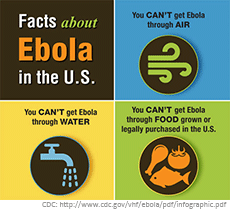
The possible spread of the Ebola virus to persons in the United States has raised concerns regarding the handling of insurance claims that might result from this disease.
As the leading North American provider of claims management services, Sedgwick offers many resources to assist our clients during times of uncertainty. From the initial report of the claim, each line of business has best practices in place to manage claims related to threats to public health, such as the Ebola virus. We have developed these best practices with flexibility enterprise-wide to meet the needs of our clients and ensure we are prepared to handle these potential claims. Please be assured that if Sedgwick receives an Ebola claim, we will not only notify our clients and carrier partners immediately, but also follow any special handling instructions and our own established best practices.
To ensure we are prepared to assist our clients during this time of uncertainty, we have educated Sedgwick colleagues regarding Ebola, its transmission and proper medical treatment. Additionally, we have established an internal Ebola information site for our colleagues who handle claims. Continue reading to learn some of the Ebola facts we've shared with our colleagues and clients.
What is Ebola?
Ebola virus disease (EVD) is a severe, often fatal illness in humans caused by infection with one of the Ebola virus strains. There are five known strains of the Ebola virus, four of which are known to cause disease in humans. The Zaire strain is the source of the current outbreak.
Ebola was first discovered in 1976 near the Ebola River in what is now the Democratic Republic of the Congo. Since then, outbreaks have appeared sporadically in Africa. The 2014 Ebola epidemic is the largest in history, affecting multiple countries in West Africa.
How is Ebola transmitted?
According to the Centers for Disease Control and Prevention (CDC), the Ebola virus can be spread through direct contact of broken skin due to an open cut, wound or abrasion or mucous membranes in, for example, the eyes, nose, or mouth with:
- Blood or body fluids including but not limited to urine, saliva, sweat, feces, vomit, breast milk and semen of a person who is sick with Ebola
- Objects such as needles, syringes and medical equipment that have been contaminated with the virus
- Infected animals
Ebola is not spread through the air or by water, or, in general, by food. However, in Africa, Ebola may be spread as a result of handling bushmeat (wild animals hunted for food) and contact with infected bats. There is no evidence that mosquitos or other insects can transmit Ebola virus. Only mammals (e.g., humans, bats, monkeys and apes) have shown the ability to become infected with and spread Ebola virus.
How long can Ebola live outside the body?
In a perfect environment, Ebola can live for up to six days outside the body. In most cases, it is believed that it lives for only a few hours. UV light, heat and exposure to oxygen deactivate the virus over time. Ebola can be killed on surfaces by using bleach, any EPA approved disinfectants, or household cleaning products like Clorox or Lysol. The virus depends on a human or an animal host to survive. It does not survive long in water, and contamination of our water system is unlikely.
What are the signs and symptoms of Ebola?
Symptoms may appear from two to 21 days after exposure to Ebola, but the average is eight to 10 days. A person infected with Ebola is not contagious until symptoms appear. Signs and symptoms of Ebola typically include:
- Fever greater than 101.5 degrees Fahrenheit
- Severe headaches
- Muscle pain
- Vomiting
- Diarrhea
- Stomach pain
- Unexplained bleeding or bruising
Diagnosis and treatment of Ebola
There are several laboratory tests used to confirm the diagnosis of Ebola. Although experimental medications and vaccines for Ebola are under development, there is currently no cure and no vaccine for this virus. The patient is isolated to prevent the spread, and then symptoms are treated as they manifest with interventions such as:
- Providing intravenous fluids (IV) and balancing electrolytes (body salts)
- Maintaining oxygen status and blood pressure
- Treating other infections if they occur
Recovery from Ebola depends on the patient’s immune response. Once someone recovers from Ebola, they can no longer spread the virus. However, Ebola virus has been found in semen for up to three months. People who recover from Ebola develop antibodies that last for at least 10 years or longer.
More information
Helpful Ebola information resources include:
- CDC Ebola Virus Disease website
- World Health Organization (WHO) Ebola Virus Disease website
- National Institute for Occupational Safety and Health (NIOSH) Ebola information
- Occupational Safety & Health Administration (OSHA) Ebola information
How you are preparing for the possibility of Ebola claims? You can contact Sedgwick’s medical director, Dr. Teresa Bartlett, for more information on Ebola as a workplace health issue. For additional perspective on how potential Ebola claims may impact the U.S., post your questions for me in the comment section below.
Download a printable copy of this Ebola fact sheet or pick one up and discuss with our experts at this week's National Workers' Compensation and Disability Conference - booth #1617.
Desiree Tolbert, National Technical Compliance Manager